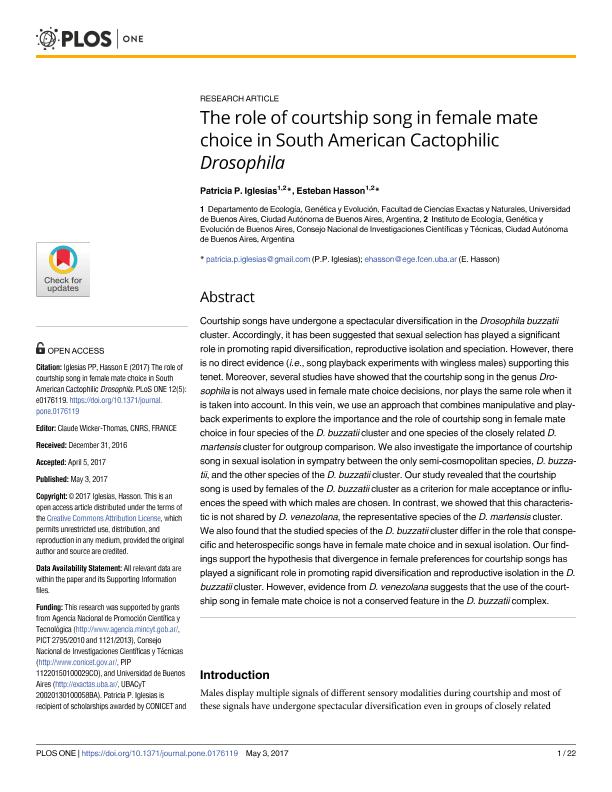Mostrar el registro sencillo del ítem
dc.contributor.author
Iglesias, Patricia Paola

dc.contributor.author
Hasson, Esteban Ruben

dc.date.available
2024-03-21T10:05:13Z
dc.date.issued
2017-05
dc.identifier.citation
Iglesias, Patricia Paola; Hasson, Esteban Ruben; The role of courtship song in female mate choice in South American Cactophilic Drosophila; Public Library of Science; Plos One; 12; 5; 5-2017; 1-22
dc.identifier.issn
1932-6203
dc.identifier.uri
http://hdl.handle.net/11336/231093
dc.description.abstract
Courtship songs have undergone a spectacular diversification in the Drosophila buzzatii cluster. Accordingly, it has been suggested that sexual selection has played a significant role in promoting rapid diversification, reproductive isolation and speciation. However, there is no direct evidence (i.e., song playback experiments with wingless males) supporting this tenet. Moreover, several studies have showed that the courtship song in the genus Drosophila is not always used in female mate choice decisions, nor plays the same role when itis taken into account. In this vein, we use an approach that combines manipulative and playback experiments to explore the importance and the role of courtship song in female mate choice in four species of the D. buzzatii cluster and one species of the closely related D. martensis cluster for outgroup comparison. We also investigate the importance of courtship song in sexual isolation in sympatry between the only semi-cosmopolitan species, D. buzzatii, and the other species of the D. buzzatii cluster. Our study revealed that the courtship song is used by females of the D. buzzatii cluster as a criterion for male acceptance or influences the speed with which males are chosen. In contrast, we showed that this characteristic is not shared by D. venezolana, the representative species of the D. martensis cluster. We also found that the studied species of the D. buzzatii cluster differ in the role that conspecific and heterospecific songs have in female mate choice and in sexual isolation. Our findings support the hypothesis that divergence in female preferences for courtship songs has played a significant role in promoting rapid diversification and reproductive isolation in the D. buzzatii cluster. However, evidence from D. venezolana suggests that the use of the courtship song in female mate choice is not a conserved feature in the D. buzzatii complex.
dc.format
application/pdf
dc.language.iso
eng
dc.publisher
Public Library of Science

dc.rights
info:eu-repo/semantics/openAccess
dc.rights.uri
https://creativecommons.org/licenses/by-nc-sa/2.5/ar/
dc.subject
Drosophila
dc.subject.classification
Otras Ciencias Biológicas

dc.subject.classification
Ciencias Biológicas

dc.subject.classification
CIENCIAS NATURALES Y EXACTAS

dc.title
The role of courtship song in female mate choice in South American Cactophilic Drosophila
dc.type
info:eu-repo/semantics/article
dc.type
info:ar-repo/semantics/artículo
dc.type
info:eu-repo/semantics/publishedVersion
dc.date.updated
2018-10-23T18:32:41Z
dc.journal.volume
12
dc.journal.number
5
dc.journal.pagination
1-22
dc.journal.pais
Estados Unidos

dc.journal.ciudad
San Francisco
dc.description.fil
Fil: Iglesias, Patricia Paola. Consejo Nacional de Investigaciones Científicas y Técnicas. Oficina de Coordinación Administrativa Ciudad Universitaria. Instituto de Ecología, Genética y Evolución de Buenos Aires. Universidad de Buenos Aires. Facultad de Ciencias Exactas y Naturales. Instituto de Ecología, Genética y Evolución de Buenos Aires; Argentina
dc.description.fil
Fil: Hasson, Esteban Ruben. Consejo Nacional de Investigaciones Científicas y Técnicas. Oficina de Coordinación Administrativa Ciudad Universitaria. Instituto de Ecología, Genética y Evolución de Buenos Aires. Universidad de Buenos Aires. Facultad de Ciencias Exactas y Naturales. Instituto de Ecología, Genética y Evolución de Buenos Aires; Argentina
dc.journal.title
Plos One

dc.relation.alternativeid
info:eu-repo/semantics/altIdentifier/url/http://journals.plos.org/plosone/article?id=10.1371/journal.pone.0176119
Archivos asociados
